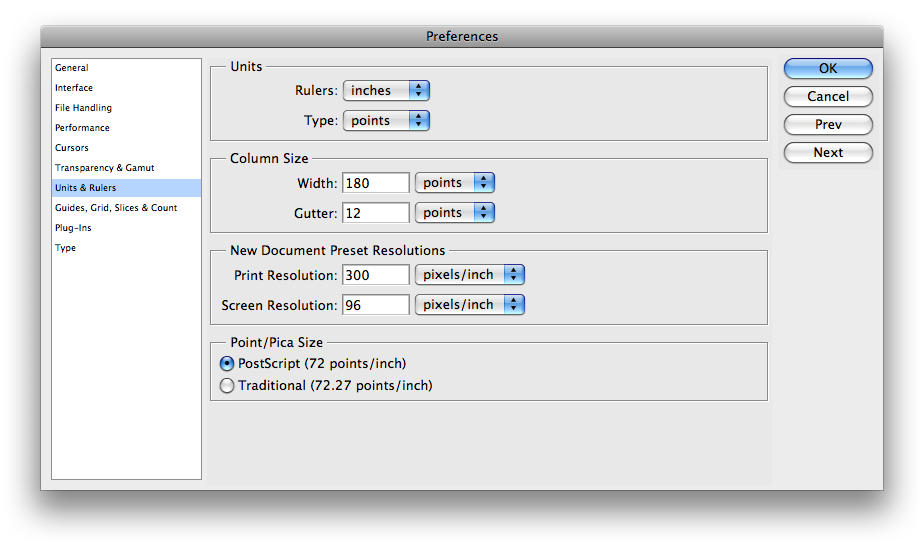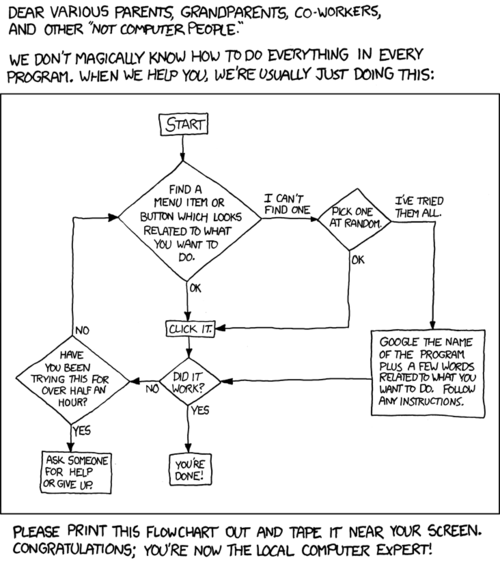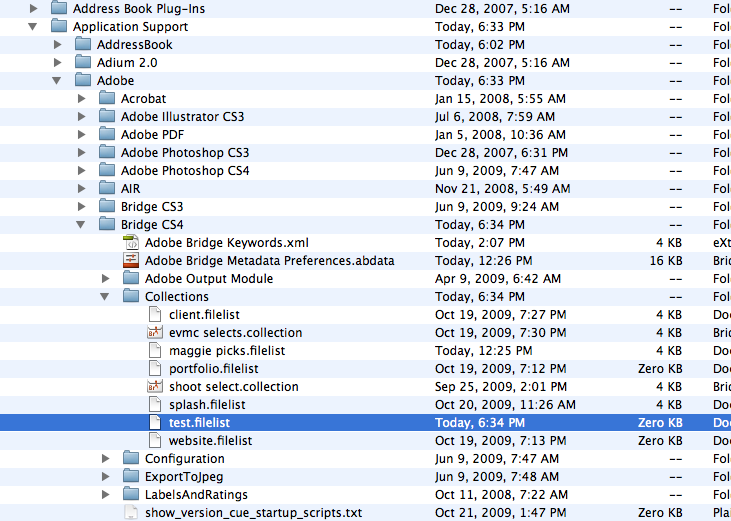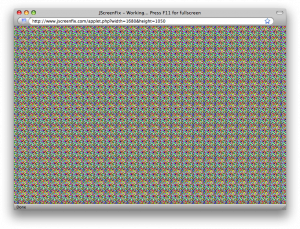OK kids- every once in a while you’re going to get some noise or aliasing- that nasty pronounced red, green or blue fringing on sharp edges of detail like hair and twill patterns- or the colored grainy stuff you see in shadows when the ISO is a little too high. Here’s a secret trick to fix it.
May 20, 2010
May 14, 2010
You too can be a geek!
We’re pretty good at having answers, and when we don’t, finding them… not to tip our hands or anything, but here’s a little flowchart we use a lot. You know… when nothing else works. Which is hardly ever. …no, really! 
(Nods to coupdegrace!)
April 24, 2010
Tips for Working on a Computer
For most of us who’ve used our own studio or darkroom, it can be a place devoted solely to work. It can be a haven, a respite from the distractions of the day; it can be a place where you take the phone off the hook, close the door, turn the music on, and concentrate on your work. The darkroom and the studio are a way to shut the world out.
The computer, however, is just the opposite. The machine on your desk is a portal to the entire world. It is anything but a refuge—it is a doorway to endless varieties of distraction.
In a great story by Louis Lesko titled, “Are We Better Off?” from the magazine Digital Photo Pro, (July 8, 2005), Louis talks about working on a print for hours, only to produce nothing usable. He was being constantly distracted by surfing the web, emails, his cell phone, IM, and who knows what else. He then came in to the studio fresh, took virtually everything off the hook, and in about half an hour produced a perfect print.
Louis offered a guideline of productive working habits, which I’ve amended here. If you follow these guidelines and are aware of the problem, you’ll get more and better work done in less time.
Working on a Computer: Rules to Live and Work By
Courtesy of Louis Lesko (“Are We Better Off?” from Digital Photo Pro, July 8, 2005)1. Check email only three specific times a day. (i.e., morning, after lunch, before leaving studio).
2. Cancel all email alerts subscriptions.
3. Turn off cell phone during non-business hours. Not silent, OFF.
4. Set time limit on Internet browsing.
5. If you exchange email with someone more than twice about the same subject, pick up the phone.
6. Get in touch with new contacts by phone only.
7. Take one day a week off. No computer, no phone. (To quote Louis, “Trust me—all that crap you think you’re missing will all be there the following day.”)
Lou Lesko’s GREAT site is here.
Even better, why not do exactly what you would do in a darkroom? Why not set up a nice quiet area to work, where there are no distractions? How about a dedicated workstation with a printer that has no access to the web? It’s a crazy idea, but maybe crazy enough that it might just work. Hmmm.
Back in the 1980s, it was CB radio (good buddy) that gave us an endless stream of useless information to distract us. Thankfully, CB radio has all but left the public consciousness. I think it’s safe to say that the Internet, cell phones, IM, and email are not going away soon. We must learn to work with them, not in spite of them.
(Excerpt from Raw Pipeline- courtesy of Ted Dillard -Lark Books)
April 21, 2010
Moving Collections in Bridge
We use Bridge constantly to sort and classify files, (and we work with a whole lot of files). The Collections feature in Bridge is incredibly powerful. It allows you to rate or classify a number of files across several locations and then display them in one group, as if all those files from all over the place are sitting in one nice little folder. Here’s the fun part: You can make the Collection, and then actually move the Collection to another workstation. This is a wonderful thing if you’re storing files on a network or a RAID with several systems accessing them…
Here’s how it works:
Go into the your User folder, find the Application Support folder. You’re looking for a file that looks like this: yourfile.filelist. Move that file from one computer to the other, and that will move the collection too. Here’s a look at where it lives-
April 14, 2010
March 24, 2010
“Print Size” Zoom not matching up? Go to your Prefs!

When you’re sharpening or retouching, I always like to look at the image at “Print Size”, but it never actually goes to an accurate print size. My solution has always been to turn my Rulers on and estimate the Zoom until they looked like they were right. One inch on screen displaying at about an inch, actual…
Go to Photoshop Prefs, to Units and Rulers. Set the screen res to your ACTUAL resolution, not the default of 72. (Find that simply by looking at your System Profiler, shown here. Measure the bottom edge of your display, divide that into your horizontal pixel dimension. In my case, it’s 1280/12.5″, or 102.4 ppi. OR, go here, to enter your diagonal dimension and your “resolution”, to get actual ppi.)
March 21, 2010
LCD monitors, image “persistance” info, fixes
Image persistence, in LCD monitors, is when you leave an image up for a while, and the can see a “ghost” of it after it’s gone.
The best brief explanation of it is here:
“LCD Image Persistence- Can Burn-In Happen to LCD Monitors?
By Mark Kyrnin, About.com”
Here’s some explanation of how to fix it- from www.syeager.org
And this, too, about fixing stuck pixels, too. PaulSpoerry.com
This refers to JScreenfix. Free. Fun.
Thanks to Adam Abel, from Lacie, for the help and links!
February 23, 2010
Film vs. Digital- the Photographer as Poet

A whole lot has been made of this question, film vs. digital, and it all brings me back to my days studying Philosophy, when Steve Weber said that the essence of Philosophy, the “Study of Wisdom”, was in asking a good question- not necessarily finding the “right” answer. Whether film or digital is better is a bad question, because it doesn’t lead to understanding either medium. The question really is, “How does digital photography change how we see, and create, as artists?”
This certainly is the question of the day, as photographers, but really, has significance in any medium that allows digital, or non-linear editing as part of the creative process. The process itself, whether photography, music or film/video, has changed profoundly from a sequence that limits the artist to what was captured (with film, in photography), processed, and then interpreted in a print, to a process that allows the artist to combine and recombine elements at will, limiting the editing process only by the elements collected- either at the original capture, or afterwards.
The medium has moved, by virtue of digital editing, from a characteristic limitation of a particular tool (think pencils, charcoal, watercolor or black and white film, for example), to a virtually unlimited characteristic- you could say there is any characteristic, or no particular characteristic at all- of digital photography and Photoshop.
How many times have we seen the phrase “…limited only by your imagination” in digital product advertising? This is precisely the point.
Let’s take this to an example. I load my camera with film. Before I do this, I make a very deliberate decision to choose a certain type of film, and that defines how I will see my subject. If I choose black and white film, I’ve consciously decided to limit my palette to a scale of gray. I must make my photographs, I must visualize, in shades of gray. I have imposed the limitations of my medium, in this case, my film, on my creative process at the outset.
We could take this to an even more basic level- imagine the artist picking up a charcoal pencil to start a drawing. That choice, the charcoal over another type of pencil, over pen and ink, over the brush, will define the work. From that point, there is no turning back, but more importantly, the expression of the work will be a result of the artist’s unique relationship, understanding, vision of that tool, that medium. We find the work beautiful and expressive precisely because of what the artist has expressed with such a limited tool.
As I go out to make photographs with my digital camera, it’s quite a different process. I must decide, at the outset, if I am shooting for black and white. I will set my camera appropriately, but if I am shooting RAW format files, I can re-interpret the files virtually any way I decide to once I’m in the editing process. My capture process is not limited by my medium.
Where does the interpretation of the digital medium come from? It comes from me. It comes from my own self-discipline, from my decision that I am, today, “shooting black and white”.
This is the profound change. Where I once simply loaded my camera with Tri-X and used D76 and a certain paper to make my prints, and allowed those media to define my photographic style and vision, I now have to make, and hold myself to, a very conscious decision. How will I shoot, what will I capture? How will I assemble the elements to fulfill my vision, my expression? More to the essence of what the artist is doing, “What am I trying to say, and how will I use the tool to say it?”
Here’s the best example I know- black and white digital processing. When you shoot RAW files with a digital camera and process to make a black and white print, the very core of what you are doing is deciding how, exactly, the colors of the subject will be rendered as tones of gray. You can quite literally interpret the color spectrum as grayscale in any way you want. When you shoot with film, the film is what makes that decision- the film is what takes colors of the subject and renders them to grays.
When I shoot black and white with film I’m limited by the film. When I shoot black and white with a digital camera the limitation must be self-imposed. I’ve moved the discipline from the medium to myself.
In a recent discussion the comment was made that discussion and argument moves the intellect, but that poetry moves the soul. Why? It is precisely because the poet expresses our innermost feelings with words. Words. When we use reason and rhetoric we use every word we can to cajole and convince. The poet uses only those words, and specifically those words, which express and imply- words that mean more than they say, to speak that which cannot be spoken- to speak to the soul.
With the entire human language at the poet’s fingertips, the poet must use discipline instinct, understanding, wisdom, intellect- to select, and present, only those words that serve the vision of the soul.
We must not be artists, painters… photographers anymore. We must be learn to be poets.
January 1, 2010
About the Author
 Ted Dillard is a veteran commercial photographer, digital imaging evangelist, teacher and author. From the Pixel Institute at EP Levine, to his current classes at Northeastern University in Boston, he’s worked for over a decade helping photographers translate their film-based photography experience to their work with digital tools. His Pipeline series of books guides the photographer through the correct systems and processes to assure a safe, high quality and efficient process. He is the Manager of Imaging Services here at Parrot, working with the Cruse Scanner, the Parrot and Angelica product line development, as well as the Fine Art Reproduction printing Parrot provides and Parrot’s unrivaled technical support and consulting.
Ted Dillard is a veteran commercial photographer, digital imaging evangelist, teacher and author. From the Pixel Institute at EP Levine, to his current classes at Northeastern University in Boston, he’s worked for over a decade helping photographers translate their film-based photography experience to their work with digital tools. His Pipeline series of books guides the photographer through the correct systems and processes to assure a safe, high quality and efficient process. He is the Manager of Imaging Services here at Parrot, working with the Cruse Scanner, the Parrot and Angelica product line development, as well as the Fine Art Reproduction printing Parrot provides and Parrot’s unrivaled technical support and consulting.
Contact Ted here via email, or call at (877) 727-7682.
When Ted’s not fixing pixels, he’s building, writing about and riding electric motorcycles! Check out his blog, The Electric Chronicles, for a taste of something completely different!
For more info, visit Ted’s profile on LinkedIn.


